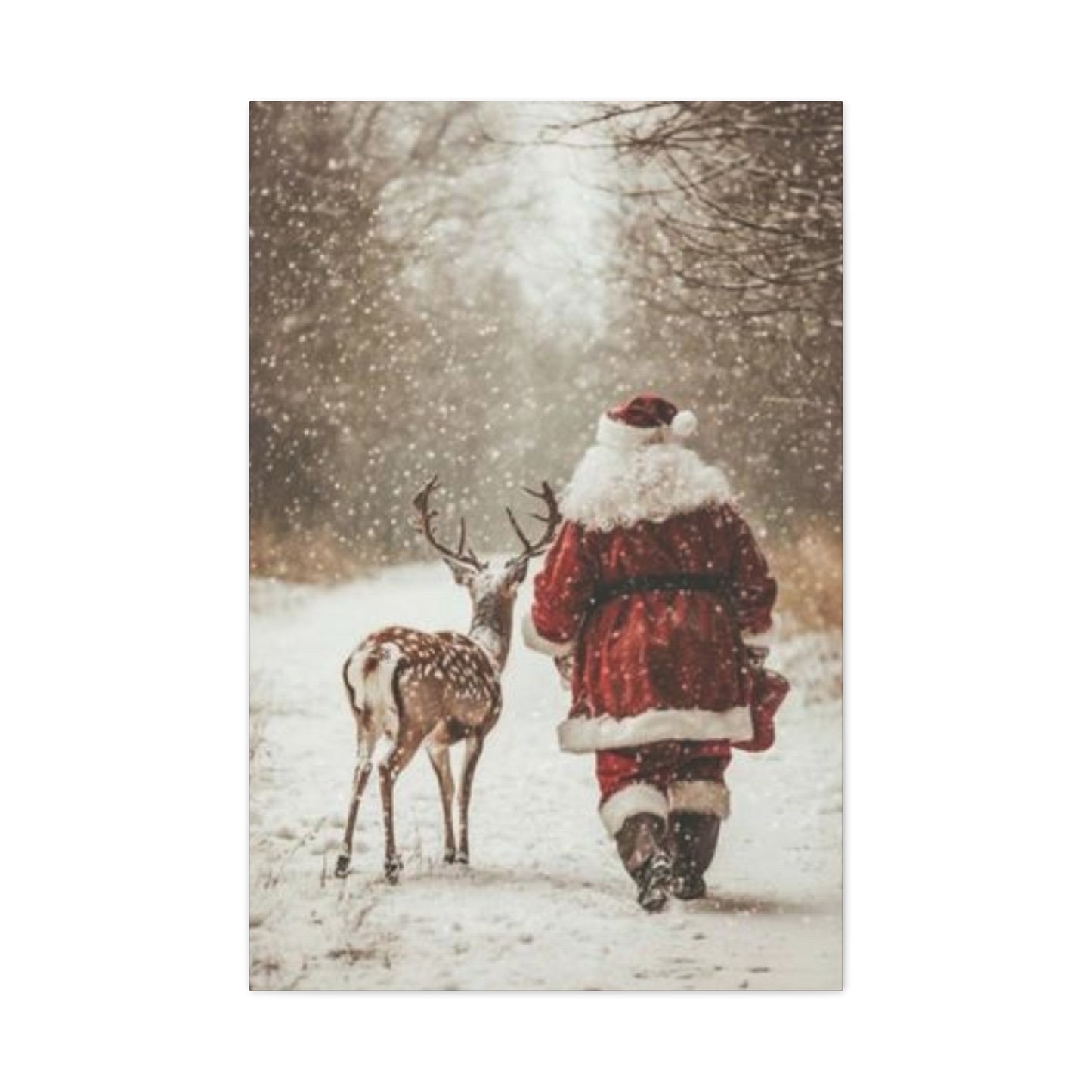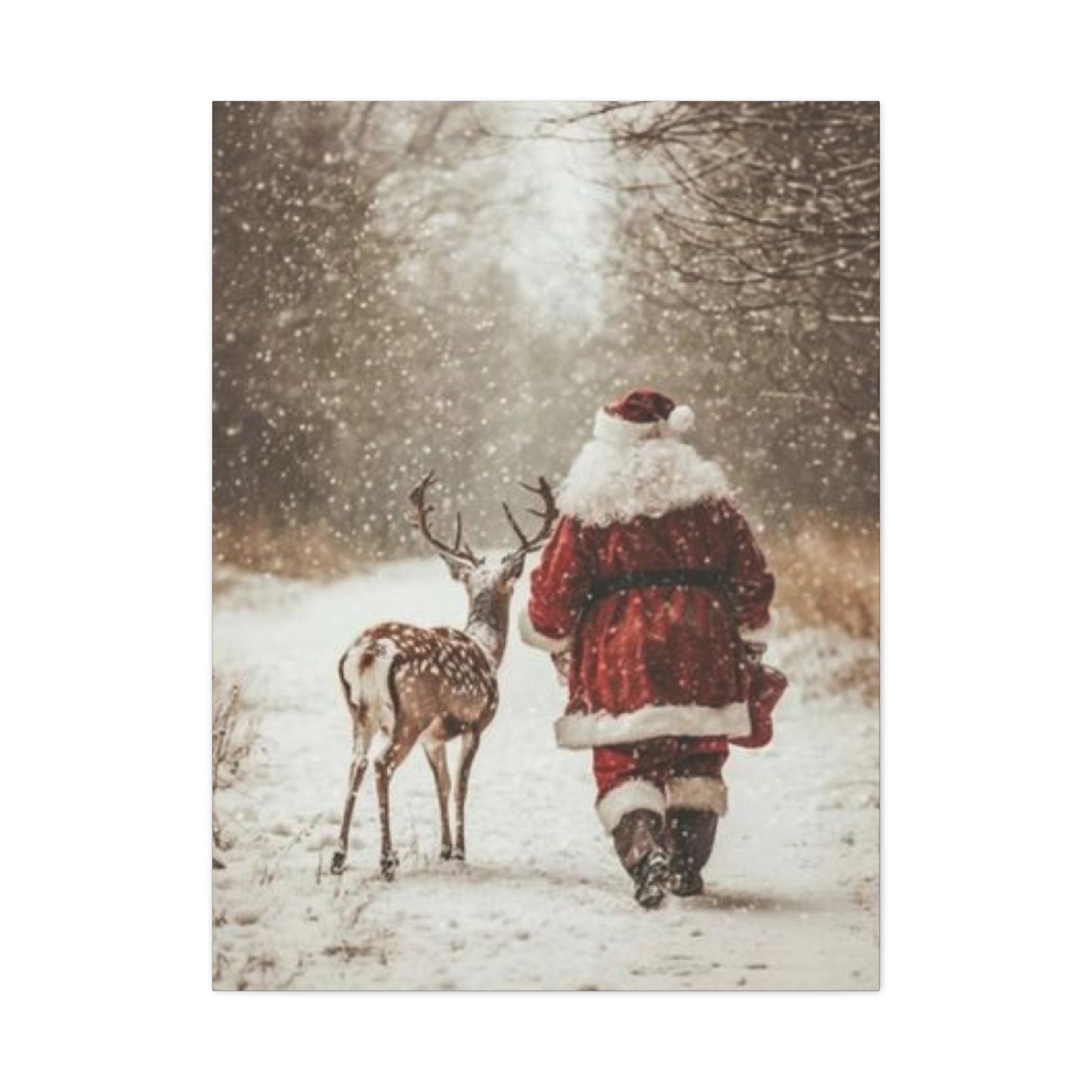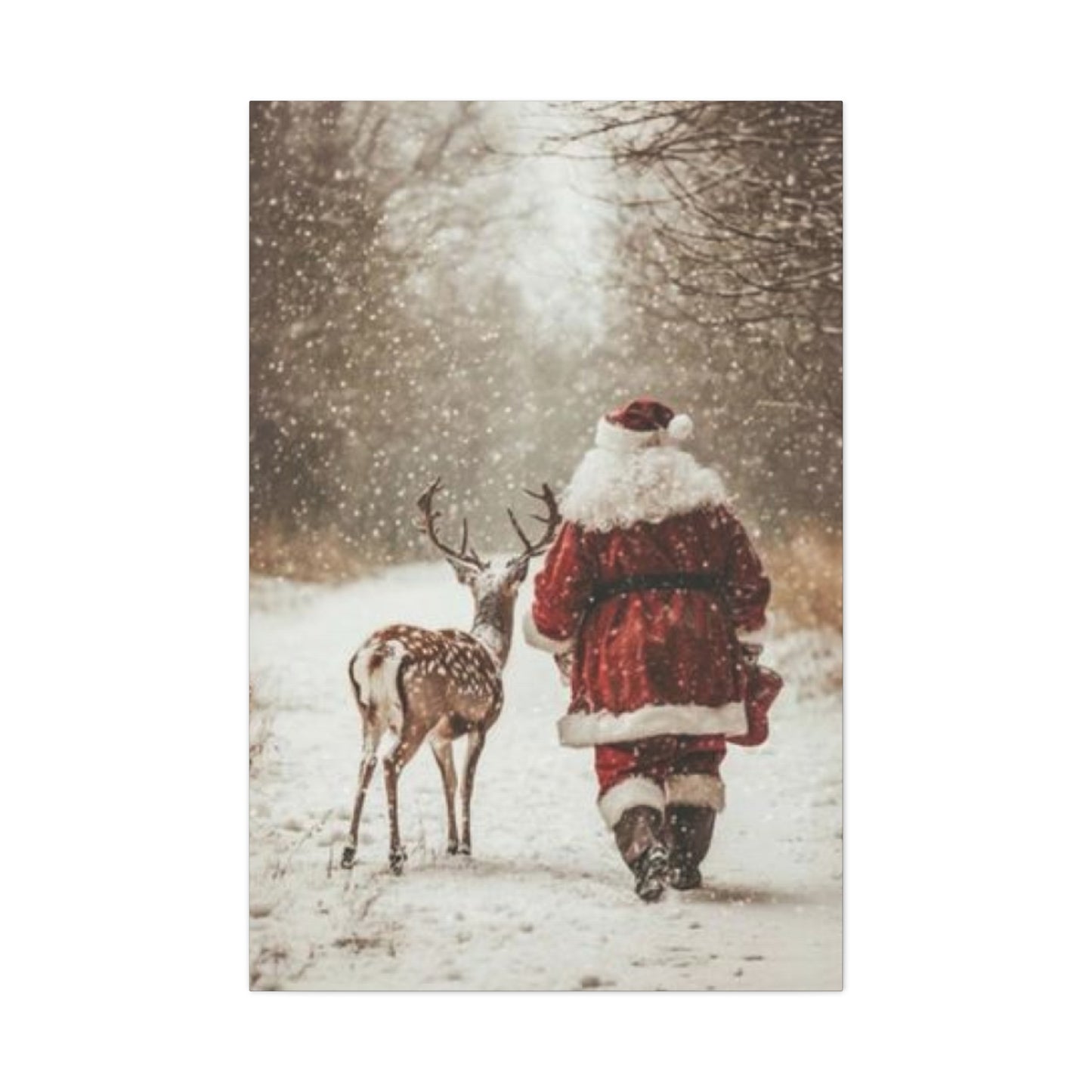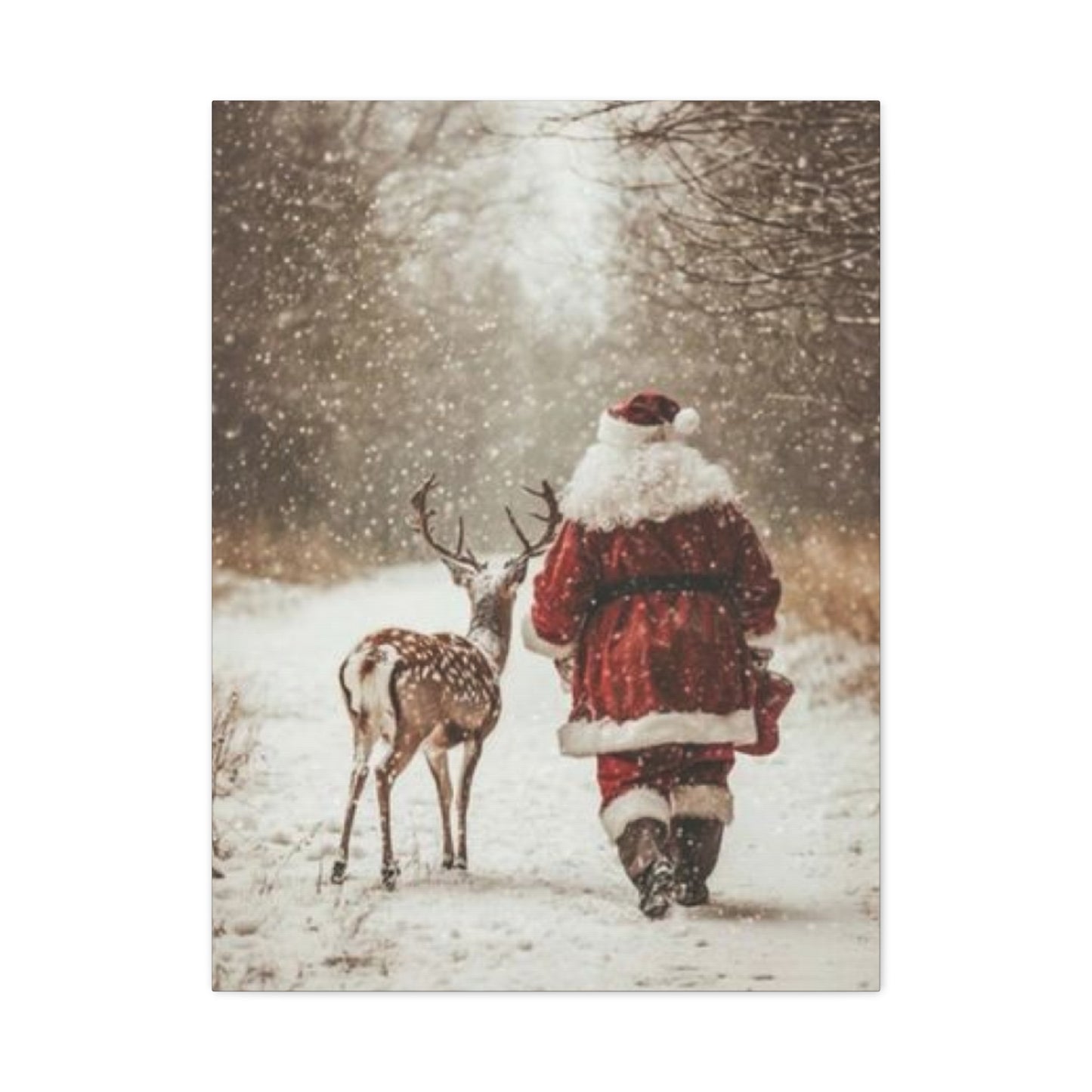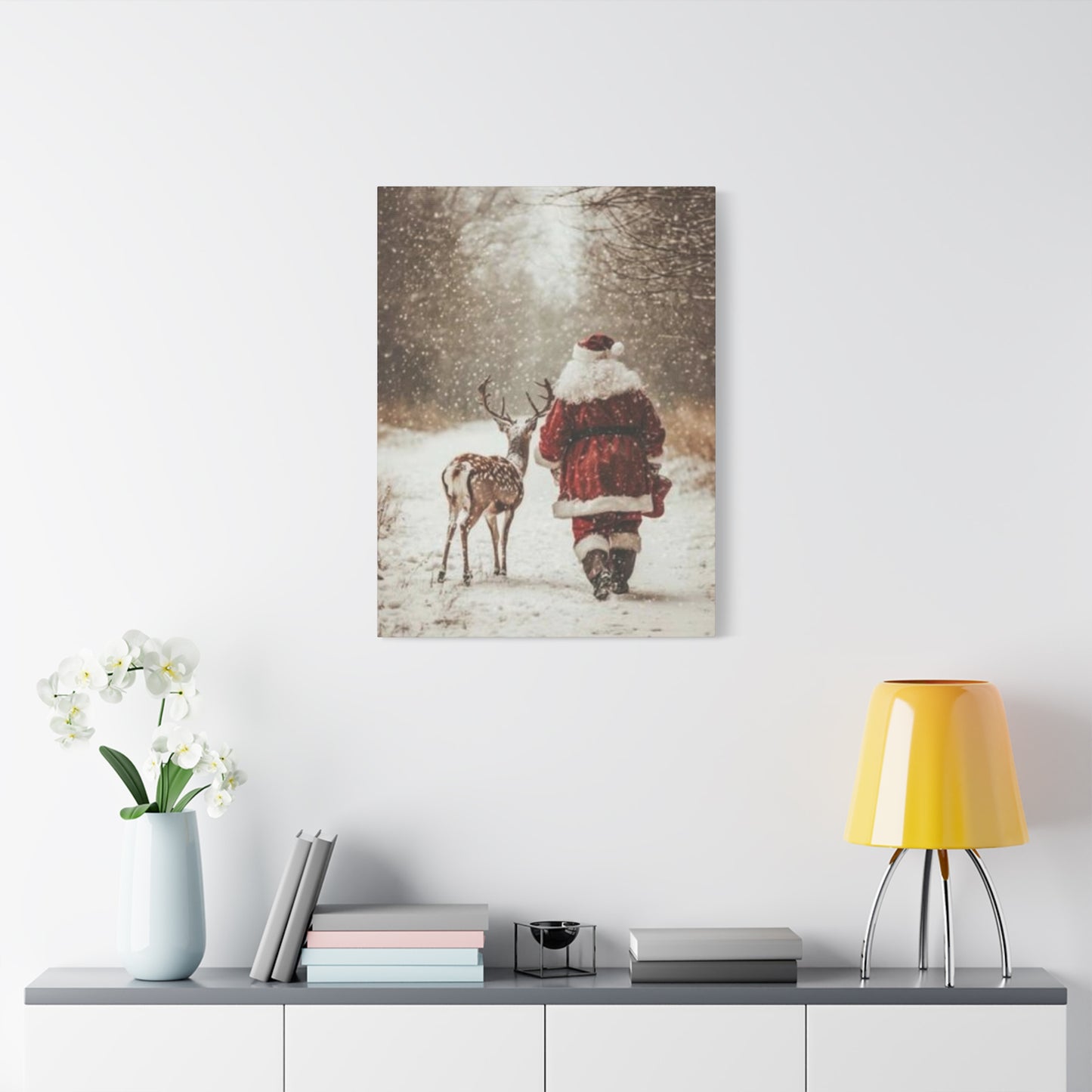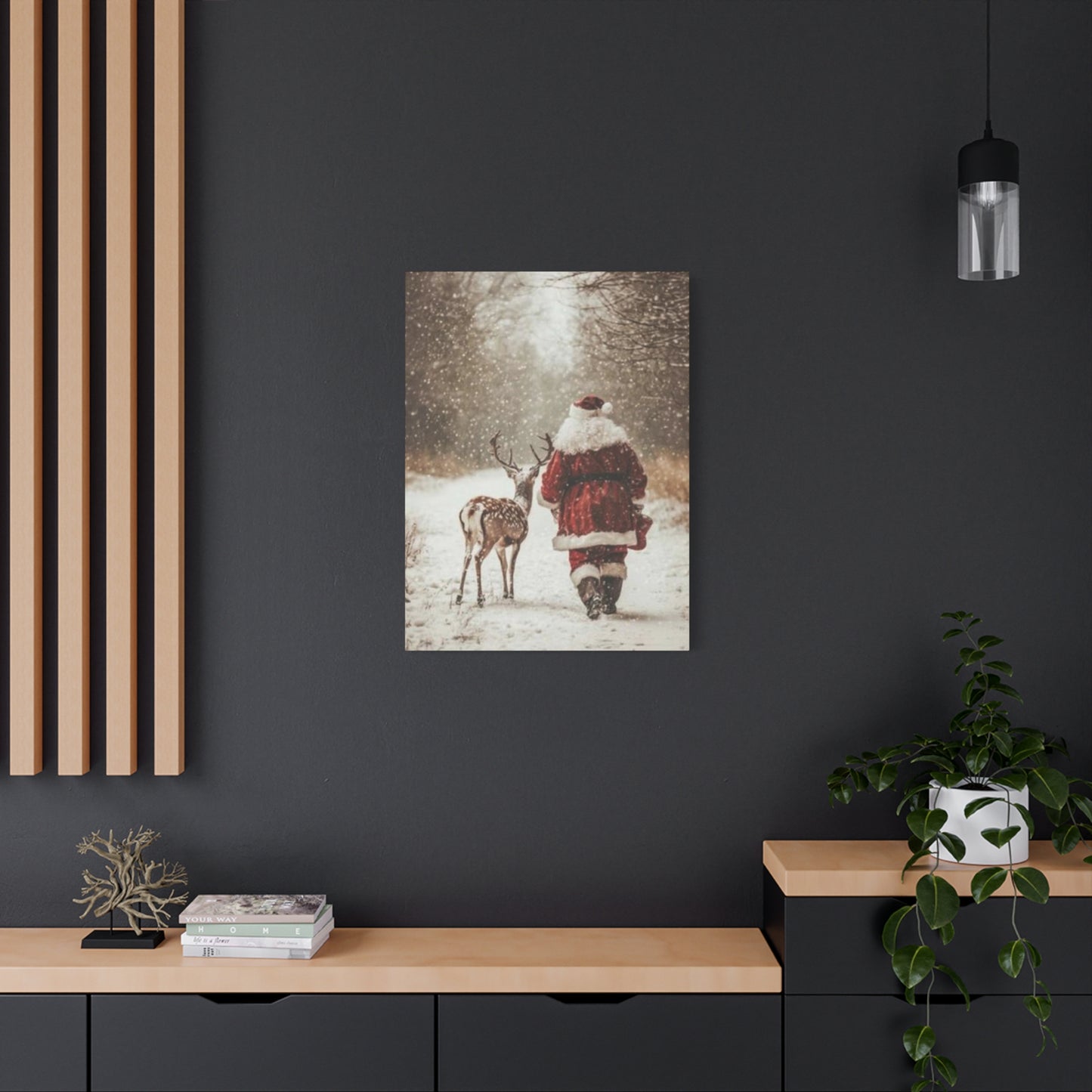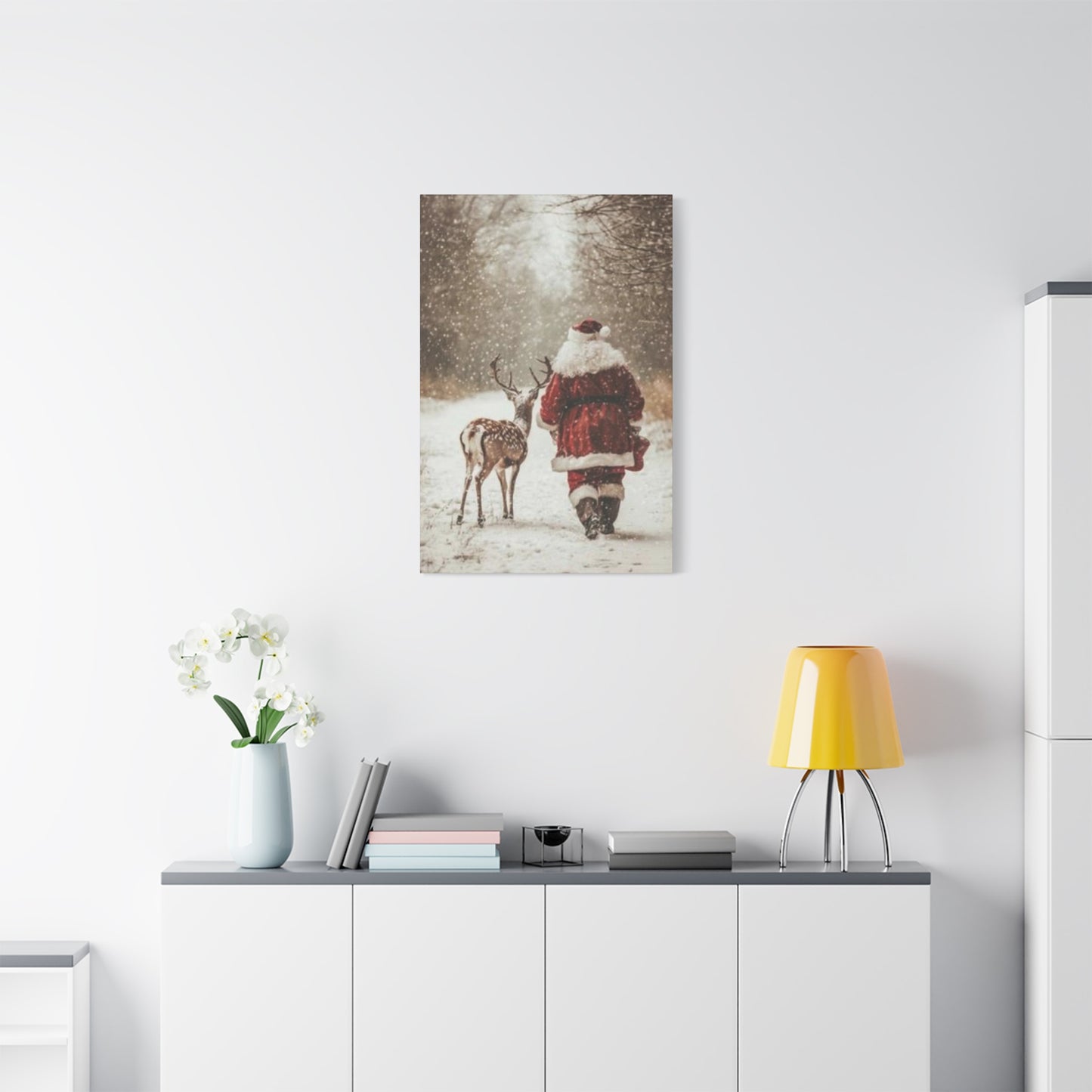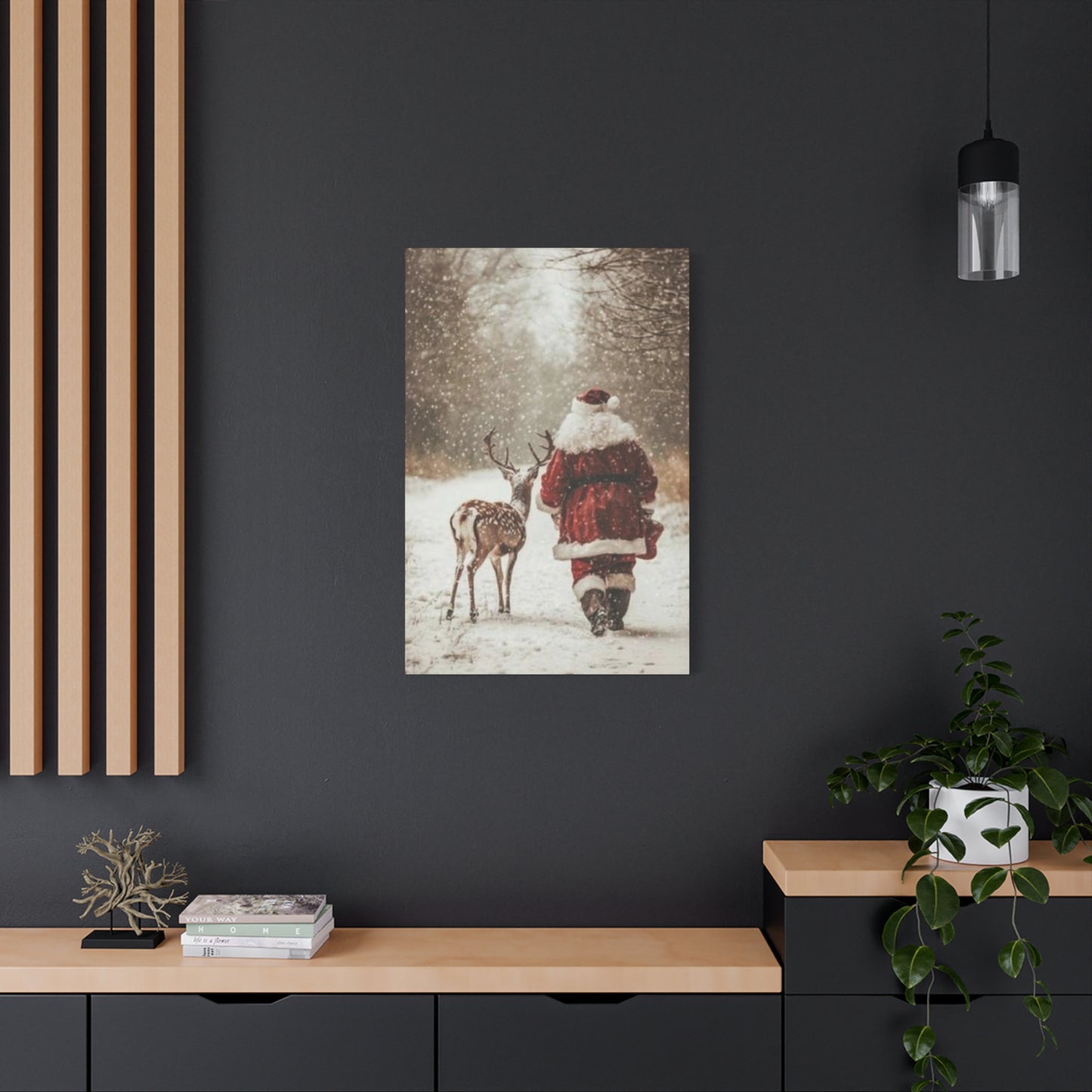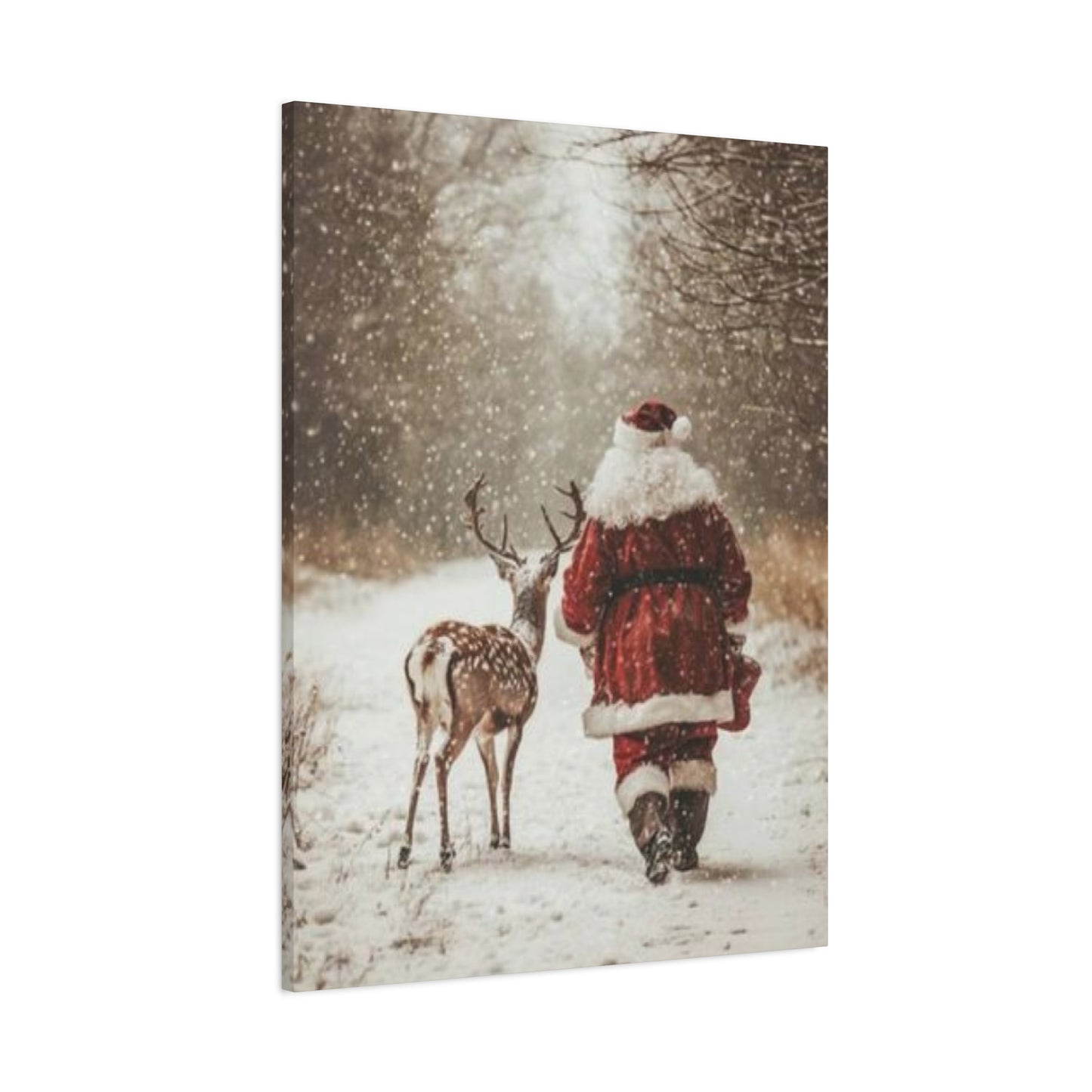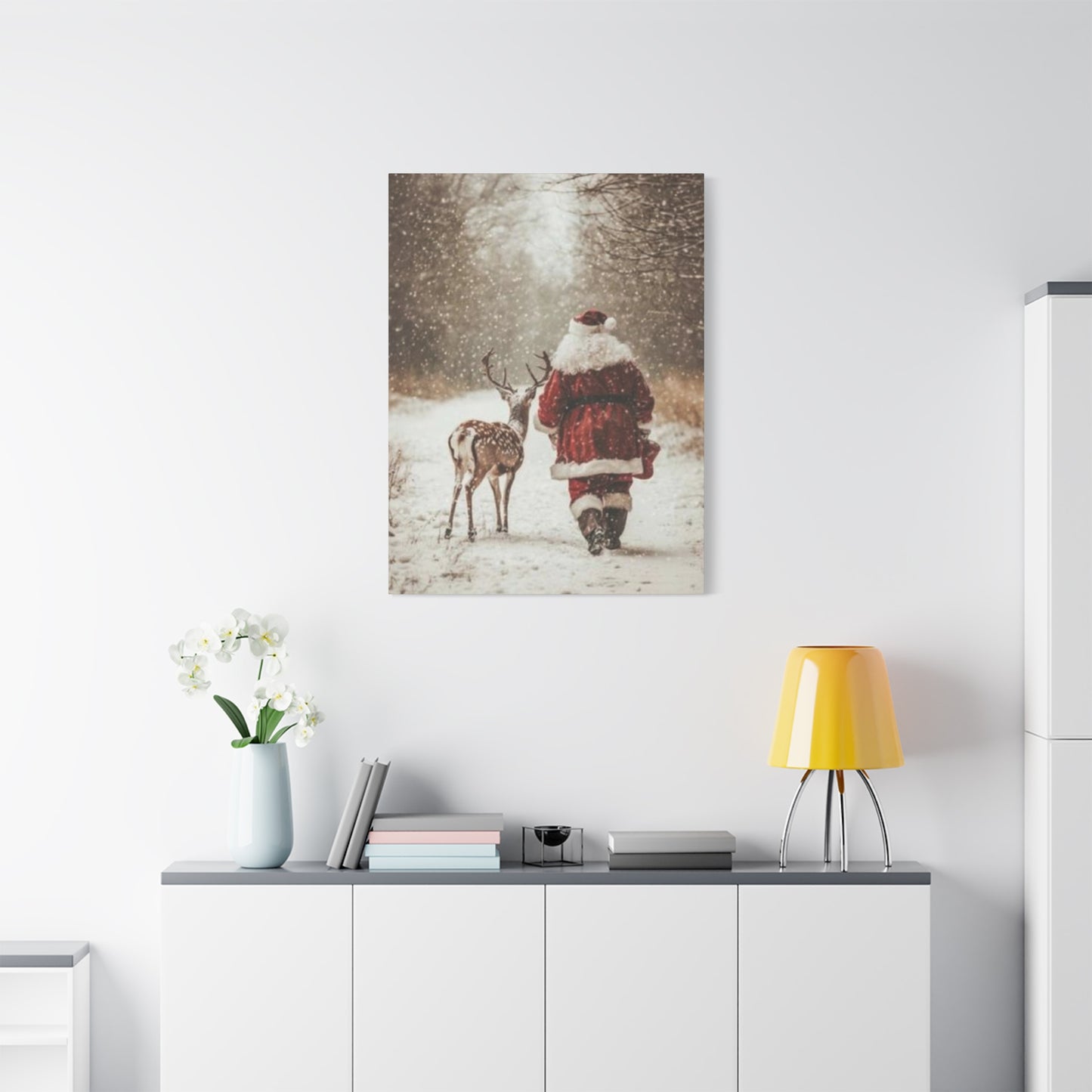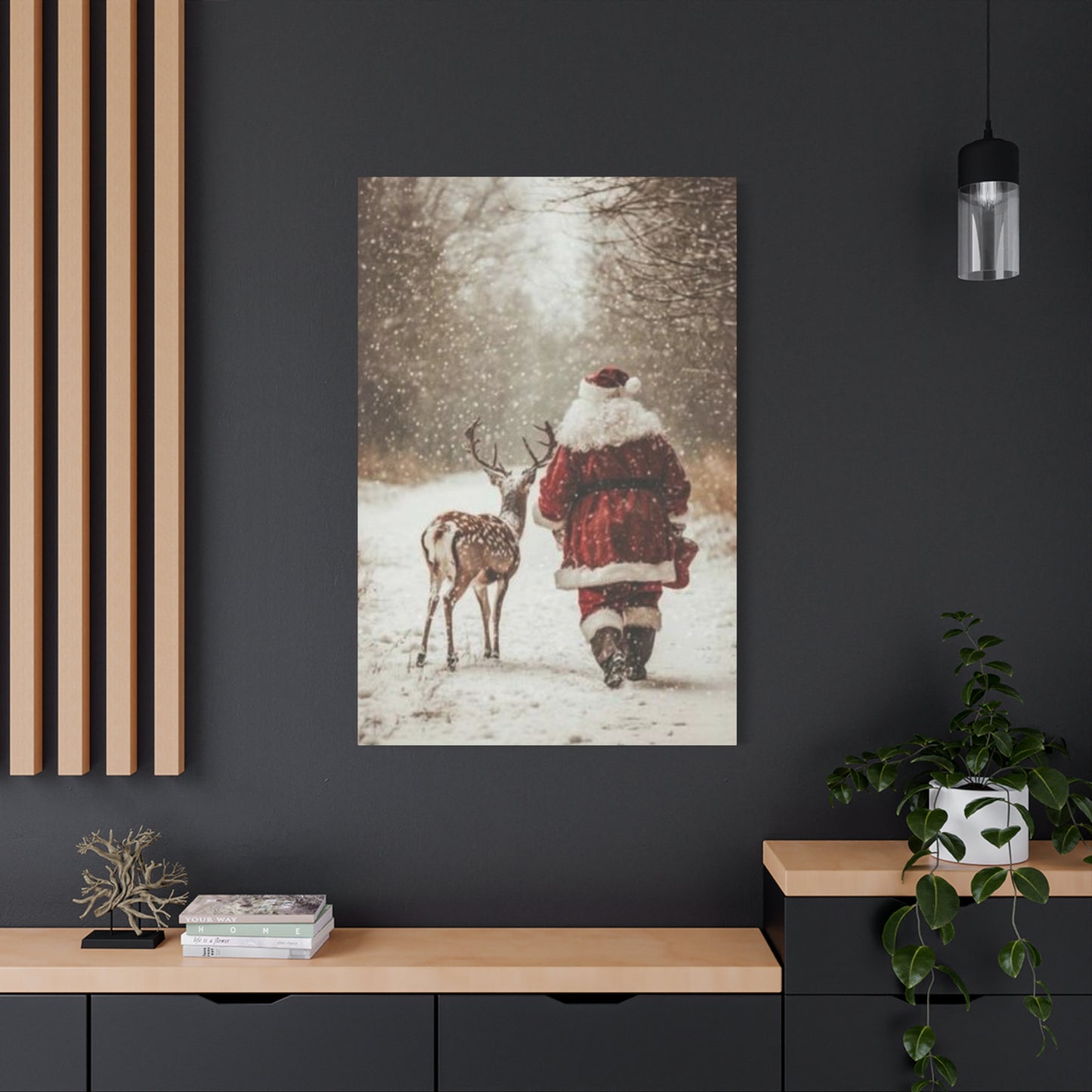The Enduring Allure of Santa Claus Deer Wall Art Prints for Festive Interiors
The arrival of the holiday season brings with it a unique desire to transform our living spaces into havens of warmth, joy, and festive cheer. As we deck the halls, every decorative choice we make contributes to the overall ambiance and the memories we create. Among the myriad of options available, one particular theme consistently captures the heart of the holidays: the iconic pairing of Santa Claus and his faithful deer. This timeless duo, immortalized in stories, songs, and visual media, finds a particularly elegant and impactful expression in the form of Santa Claus deer wall art canvas prints. This form of decoration is more than just a seasonal accessory; it is a narrative piece, a focal point, and a vessel of nostalgia that can elevate any room's festive atmosphere.
The choice of a canvas print as the medium offers a sophisticated, gallery-quality feel that distinguishes it from more temporary decorations. It brings depth, texture, and a sense of permanence to the joyful imagery of Christmas. Whether depicting a serene winter landscape with Santa’s sleigh soaring across the moonlit sky or a charming, detailed portrait of St. Nicholas with a gentle reindeer, these artworks tap into a deep-seated cultural affection for the symbols of Yuletide. This exploration delves into the multifaceted world of these enchanting decorations, examining their symbolic significance, artistic merit, and practical application in creating a truly magical holiday home.
Choosing the Right Size and Placement for Your Canvas Print
The impact of your Santa Claus deer wall art canvas prints depends heavily on two critical factors: its size and where you choose to hang it. Selecting the right size requires a careful consideration of the wall space and the surrounding furniture. A print that is too small for a large wall can look lost and insignificant, failing to make the intended statement. Conversely, a piece that is too large for a small space can feel overwhelming and make the room seem cramped. A helpful rule of thumb is to choose art that fills approximately two-thirds to three-quarters of the available wall space above a piece of furniture like a sofa, bed, or console table. For a standalone piece on an empty wall, ensure there is ample "breathing room" around it to prevent a cluttered look. Placement is equally important.
The center of the artwork should be hung at eye level, which is typically around 57 to 60 inches from the floor. This creates a comfortable viewing experience. Consider the primary vantage points in the room. Where will people be sitting or standing most often? Place the art where it can be easily seen and appreciated. An entryway is a fantastic location to make a festive first impression. The wall above the fireplace mantel is a classic choice, creating a cozy and traditional focal point. Even unexpected places like a hallway, a kitchen, or a guest bedroom can be brightened by a thoughtfully placed piece of holiday art, spreading festive cheer throughout your entire home.
The Role of Lighting in Highlighting Your Holiday Wall Art
Even the most beautiful piece of Santa Claus deer wall art canvas prints can lose its impact if it is not properly lit. Lighting is a powerful tool in interior design that can be used to draw attention, create mood, and enhance the details of your artwork. Poor lighting can leave your canvas in shadow, washing out its colors and obscuring its finer points. To make your holiday art truly stand out, consider dedicated accent lighting. One of the most effective methods is to use a picture light, which is a fixture mounted directly above the artwork that casts a focused beam of light down onto the canvas.
This ensures the piece is the brightest object on the wall, making it a clear focal point. Another excellent option is track lighting, where adjustable spotlights are mounted on a ceiling track. This allows you to aim one or more lights directly at the canvas, giving you flexibility in positioning and intensity. If you prefer a simpler solution, a well-placed floor lamp with an adjustable head can also be used to illuminate the art. When lighting your canvas, pay attention to the type of bulb you use. An LED bulb with a high Color Rendering Index (CRI) will display the colors of the artwork most accurately. The right lighting not only makes your art more visible but also enhances its emotional impact, making the festive scene appear more vibrant, magical, and alive.
Canvas Prints as a Cherished Family Heirloom
Holiday traditions are the threads that weave families together, creating a tapestry of shared memories and experiences. The decorations we bring out year after year become part of this tradition, imbued with the nostalgia and sentiment of Christmases past. A high-quality Santa Claus deer wall art canvas prints has the potential to become more than just a decoration; it can evolve into a cherished family heirloom. Unlike disposable decorations that fade, break, or go out of style, a well-crafted canvas print is built to last. Made with durable canvas and archival-quality inks, it can withstand the test of time, looking just as vibrant for the next generation as it did on the day it was first hung.
As this piece of art is brought out each December, it becomes a silent witness to your family's holiday celebrations. It presides over festive meals, the opening of gifts, and gatherings of loved ones. Children will grow up with the image, associating it with the magic and warmth of their childhood Christmases. In time, the canvas becomes a repository of memories, each glance evoking the spirit of holidays gone by. Passing such a piece down to children or grandchildren is a wonderful way to share a piece of your family's history and ensure that the traditions you hold dear continue for years to come. It becomes a tangible link between generations, a beautiful and enduring symbol of family and festive joy.
Abstract and Minimalist Takes on the Festive Duo
For those who appreciate a more subtle and contemporary approach to holiday decorating, abstract and minimalist art offers a sophisticated way to celebrate the season. This style moves away from literal, detailed representations and instead focuses on capturing the essence and feeling of the subject through shape, color, and form. An abstract Santa Claus deer wall art canvas prints might use a swirl of red and white brushstrokes to suggest Santa's movement, or elongated brown and gold forms to evoke the grace of his reindeer. The focus is on emotional impact rather than narrative detail. This allows the viewer to bring their own interpretation to the piece.
Minimalist art takes this a step further by stripping the theme down to its most basic elements. A minimalist canvas might feature a single, elegant line drawing of a deer's antler, paired with a simple red circle to represent Santa. The background is often a solid, neutral color, which makes the simple design elements stand out. These styles are ideal for modern, uncluttered interiors where a traditional, busy scene might feel out of place. They are a testament to the idea that festive decor can be chic, understated, and artistic. An abstract or minimalist piece allows you to express your holiday spirit in a way that is both intellectually engaging and visually serene, proving that less can indeed be more.
The Global Appeal of Santa and Reindeer Iconography
The story of Santa Claus and his flying reindeer is a relatively modern and Western creation, but its core themes of generosity, magic, and winter celebration resonate across many cultures. While different countries have their own unique gift-bringers and holiday traditions—from Saint Nicholas in parts of Europe to Ded Moroz in Russia—the image of the jolly man in the red suit has achieved remarkable global recognition. This widespread appeal is largely due to the power of media, commerce, and shared cultural narratives. The iconography has become a universal shorthand for the Christmas season, representing a spirit of joy and goodwill that transcends specific cultural or religious boundaries.
As a result, Santa Claus deer wall art canvas prints can be found in homes all around the world, from Tokyo to Buenos Aires. The imagery of a sleigh flying through a snowy night sky evokes a sense of wonder that is universally understood, even in climates where snow is never seen. The reindeer, as symbols of nature and resilience, also have a broad appeal. This global recognition makes the artwork a unifying symbol. It connects people through a shared understanding of festive celebration, reminding us that despite our diverse traditions, the desire to create a warm and magical atmosphere for our loved ones during the darkest time of the year is a common human experience. This art form celebrates a modern folklore that has been embraced by the global community.
Sustainability and Eco-Friendly Options in Canvas Art
In an increasingly environmentally conscious world, many people are seeking sustainable options for all aspects of their lives, including their holiday decorations. The world of canvas printing is adapting to this demand, and it is now possible to find Santa Claus deer wall art canvas prints that are created with eco-friendly practices. One of the key areas of focus is the ink used in the printing process. Many manufacturers are now using water-based latex or soy-based inks instead of traditional solvent-based inks. These eco-friendly inks are non-toxic, free of hazardous air pollutants, and have a much lower environmental impact, while still producing vibrant and durable colors.
The materials for the frame and canvas can also be sourced sustainably. Look for stretcher bars made from wood that is certified by the Forest Stewardship Council (FSC). This certification ensures that the wood comes from responsibly managed forests that provide environmental, social, and economic benefits. The canvas itself can be made from organic cotton or recycled materials. By choosing an eco-friendly canvas print, you can celebrate the holiday season without compromising your commitment to protecting the planet. It is a way of ensuring that the joy and goodwill represented in the artwork extend to our care for the natural world. This mindful approach to decorating adds an extra layer of meaning to your festive display, creating a home that is not only beautiful but also thoughtfully and responsibly curated.
Gifting Santa Claus Deer Wall Art: A Thoughtful Holiday Present
Finding the perfect holiday gift can be a challenge. We often look for something that is personal, meaningful, and will be genuinely enjoyed by the recipient. A beautiful piece of Santa Claus deer wall art canvas prints checks all of these boxes, making it an exceptional and thoughtful present. Unlike many gifts that are used once and then forgotten, a piece of art is a lasting treasure that can be brought out and cherished year after year. It is a gift that contributes to the recipient's home and their family's traditions. When you give a piece of art, you are giving more than just an object; you are giving an experience.
You are giving them a focal point for their holiday decor, a conversation starter for their festive gatherings, and a source of joy and nostalgia for years to come. This gift is particularly well-suited for a variety of recipients. It is a wonderful present for a newly married couple celebrating their first Christmas together in a new home, helping them start their own collection of holiday traditions. It is also a lovely gift for parents or grandparents, offering a beautiful new piece to add to their cherished collection of decorations. When selecting the art as a gift, consider the recipient's personal style and home decor to choose a piece that they will truly love. This thoughtful and elegant present is sure to be remembered and appreciated long after the holiday season has passed.
The Influence of Folklore and Mythology on Deer and Santa Depictions
The rich imagery found in Santa Claus deer wall art canvas prints is not a recent invention but is deeply rooted in centuries of folklore, mythology, and cultural traditions. The figure of Santa Claus himself is a composite, blending elements of the historical Saint Nicholas, a kind and generous 4th-century bishop, with the English figure of Father Christmas and the Norse god Odin. In Norse mythology, Odin was said to lead a great hunt through the midwinter sky on his eight-legged horse, Sleipnir, an event that shares striking parallels with Santa's midnight ride.
The reindeer, too, have a mythic history. In the traditions of many indigenous peoples of the Arctic and sub-Arctic regions, such as the Sámi of Scandinavia, reindeer are central to life and spirituality. They are seen as symbols of survival, wisdom, and safe passage. These animals were revered for their ability to thrive in the harshest of winter conditions. When the story of Santa's sleigh gained popularity in the 19th century, the choice of reindeer to pull it was a natural fit, drawing on these pre-existing cultural associations of deer with winter, magic, and the northern wilderness. The artwork we see today carries echoes of these ancient stories. A depiction of Santa and his deer is not just a Christmas scene; it is a modern interpretation of powerful archetypes—the wise old gift-bringer and his noble, otherworldly steeds—that have captivated the human imagination for millennia.
DIY Display Ideas to Complement Your Canvas Prints
Once you have your perfect Santa Claus deer wall art canvas prints, you can further enhance its presence with some creative and personalized DIY display ideas. These simple projects can frame your artwork and integrate it more deeply into your overall decor. One beautiful idea is to create a "winter window" effect. Mount the canvas on the wall and then frame it with old, rustic window panes (without the glass). This creates the illusion that you are looking through a window into a magical Christmas scene. You can even add a small window box shelf underneath, filled with faux snow, pinecones, and small ornaments.
Another idea is to create a garland frame. Use removable hooks to hang a lush evergreen garland around the perimeter of the canvas. Weave in battery-operated fairy lights, small red berries, and miniature pinecones for a festive and enchanting border. This adds dimension and a soft glow that draws even more attention to the art. For a more interactive display, you could create a "countdown to Christmas" element. Hang the canvas and then attach a string or ribbon below it with 24 small clips. Each day in December, you can clip on a small ornament, a family photo from a past Christmas, or a card with a favorite holiday memory written on it. This turns the area around your art into a dynamic and personal part of your family's daily holiday ritual.
Christmas Eve Artistic Displays for Interior Spaces
The specific association with Christmas Eve imbues certain holiday artwork with heightened narrative significance. These pieces don't merely represent generic winter scenes but capture the specific moment of Santa's gift-delivering journey, creating a sense of anticipation and wonder. Canvas art depicting Christmas Eve scenes often includes temporal markers like darkened skies, sleeping villages below, or the positioning of Santa and his team in mid-journey rather than at rest. This specificity adds storytelling depth that engages viewers beyond simple aesthetic appreciation.
Interior wall spaces designated for holiday artwork benefit from careful consideration of viewing angles and lighting conditions. Canvas pieces depicting night scenes, such as Christmas Eve flights, may appear differently under various lighting situations. Natural daylight emphasizes certain color tones, while evening artificial lighting can warm or cool the artwork's appearance depending on bulb temperature. Some collectors position adjustable spotlights to highlight these pieces during holiday seasons, creating dramatic focal points that enhance the artwork's atmospheric qualities. The wall color behind the canvas also influences perception, with lighter walls creating contrast that makes the artwork pop forward, while darker walls can create integration that makes the scene feel like a window into another world.
The psychological impact of Christmas Eve imagery relates to its connection with anticipation and possibility. Unlike Christmas morning scenes that depict aftermath and fulfillment, Christmas Eve representations capture the moment before, when magic is actively happening but remains just beyond direct witness. This positioning creates engaging tension that keeps viewers returning to the artwork, imagining the continuation of the narrative. For children, these images validate their belief in the Santa tradition and fuel excitement. For adults, they may trigger memories of their own childhood anticipation or the joy of creating that experience for others.
Scale considerations for Christmas Eve canvas art depend on the intended impact and available space. Panoramic formats allow for expansive scenes that include broad sky areas, distant landscape features, and multiple elements of the Christmas Eve narrative. Square formats create balanced, iconic presentations that work well in various architectural contexts. Vertical orientations can emphasize the height of Santa's flight or create elegant accent pieces for narrow wall spaces. The physical size of the canvas affects not only visual impact but also the amount of detail artists can effectively include, with larger pieces supporting more intricate storytelling elements.
Santa Claus Portrayed Within Winter Landscape Settings
The depiction of Santa Claus within snowy winter environments creates powerful visual narratives that combine character with setting. These compositions often show Santa either in his workshop, preparing for his journey, or navigating through winter landscapes during his delivery route. The contrast between Santa's warm, red attire and the cool whites and blues of winter scenery creates natural color harmony that is both striking and traditionally appropriate. Artists working in this genre must balance the character's prominence with the atmospheric qualities of the surrounding winter wonderland.
Winter landscape elements provide rich opportunities for artistic expression within holiday canvas work. Snow-laden evergreen trees create vertical elements that frame scenes and add depth through perspective diminishment. Frozen lakes or snow-covered fields provide expansive negative space that prevents compositions from feeling cluttered while suggesting the vastness of Santa's territory. Mountain ranges in the distance add majesty and scale, making Santa's journey appear even more impressive. Individual snowflakes, when rendered with sufficient detail, create texture and movement that enliven the scene without overwhelming the central narrative.
The characterization of Santa Claus in canvas art has evolved over decades, influenced by various artistic traditions and commercial imagery. Contemporary artists may reference classic depictions while adding personal interpretive elements. Santa's facial features, body proportions, costume details, and overall demeanor communicate specific qualities ranging from jolly and approachable to dignified and mysterious. Some artistic interpretations emphasize Santa's magical nature through ethereal lighting or symbolic elements, while others ground him in realistic detail that makes his presence feel tangibly possible. The artist's choice in Santa characterization significantly affects how viewers relate to the piece emotionally.
Seasonal weather conditions depicted in winter wonderland scenes contribute to mood and atmosphere. Gentle snowfall creates peaceful, serene settings that emphasize the quiet magic of Christmas. Heavier snow or wind-blown conditions add drama and highlight Santa's determination and capability. Clear, cold nights with visible stars establish the cosmic scope of the Christmas Eve journey. The quality of snow itself, whether freshly fallen and pristine or textured with shadows and windswept patterns, demonstrates artistic skill while building environmental realism. These atmospheric choices help viewers feel the cold beauty of winter without discomfort, instead experiencing it as an essential component of holiday enchantment.
Imaginative Holiday Canvas Artwork with Playful Elements
Whimsical approaches to holiday canvas art embrace playfulness and creative freedom, often departing from strictly realistic representation to explore more fantastical or stylized interpretations. These pieces might feature exaggerated proportions, such as reindeer with especially large eyes or Santa with an impressively flowing beard. Color palettes may venture beyond traditional reds and greens into unexpected combinations like purples and teals, or pastels that create softer, dreamier atmospheres. The whimsical approach appeals to those seeking holiday décor that feels fresh and contemporary while maintaining connection to beloved traditions.
Stylistic choices in whimsical holiday art span a broad spectrum. Some artists employ cartoon-like simplification, reducing Santa and reindeer to essential shapes and features that remain immediately recognizable while taking on graphic charm. Others might incorporate folk art influences, drawing on traditions like Scandinavian or Eastern European holiday imagery that features distinctive pattern work and symbolic elements. Abstract approaches can distill the essence of holiday themes into color fields, shapes, and suggested forms that evoke festive feelings without literal representation. These varied approaches demonstrate that holiday canvas art need not be bound by conventional expectations.
The narrative possibilities within whimsical holiday artwork expand beyond traditional story beats. Santa might appear in unexpected contexts, such as taking a cocoa break on a rooftop or consulting a comically oversized list. Reindeer could display exaggerated personalities, with some looking mischievous while others appear noble or comically confused. Background elements might include fantastical additions like candy cane forests, gingerbread architecture, or anthropomorphic snowmen assisting with deliveries. These creative departures from standard iconography create unique pieces that spark conversation and appeal to those who appreciate humor and imagination in their holiday celebrations.
The emotional tone of whimsical holiday canvas differs from more traditional or realistic approaches. Rather than aiming for nostalgic warmth or majestic wonder, these pieces typically pursue joy, delight, and lighthearted fun. This makes them particularly appropriate for spaces where children spend time, as the playful qualities resonate with younger sensibilities. However, whimsical holiday art also appeals to adults who enjoy eclectic or contemporary interior design styles, as these pieces can serve as bold accent elements that demonstrate personal style while participating in seasonal celebration. The key to successful whimsical work lies in maintaining enough connection to recognizable holiday imagery that the piece remains thematically grounded even as it takes creative liberties.
Reindeer Depicted in Celestial Flight Across Canvas
The specific focus on reindeer in flight highlights these creatures' central role in the Santa mythology. Artistic emphasis on the reindeer team allows for detailed exploration of their individual characteristics, powerful physiques, and graceful movement through the air. Some canvas works feature close-up perspectives that make viewers feel they're flying alongside the team, seeing details of their coats, the determination in their eyes, and the frost forming on their antlers. Other compositions pull back to show the entire team in formation, creating spectacular scenes that emphasize coordination and collective purpose.
The traditional naming of Santa's reindeer provides artists with opportunities to develop distinct personalities within their work. While not all pieces identify specific reindeer, those that do often assign visual characteristics that match name associations. Rudolph's red nose naturally makes him visually distinctive, often rendered with a glow that illuminates surrounding areas. Other reindeer might be differentiated through antler shapes, body markings, or subtle variations in coloring. When all nine reindeer appear together, their arrangement in teams of two with Rudolph in the lead creates compositional structure that artists can exploit for balanced, dynamic layouts.
The anatomical challenge of depicting reindeer in flight requires artistic understanding of how these animals move in their natural terrestrial environment, then translating that knowledge into aerial contexts. Real caribou and reindeer have distinctive gaits, body proportions, and movement patterns that informed observers recognize. Artists must maintain enough anatomical accuracy to keep the creatures identifiable as reindeer while adapting their posture and leg positioning to suggest flight rather than running. The result often resembles a gallop frozen in mid-leap, with legs extended in ways that would make sense during jumping but sustained as if the animal is swimming through the air.
Environmental integration of flying reindeer within canvas compositions requires attention to perspective, lighting, and atmospheric effects. Reindeer flying at high altitudes might be shown against cloud layers, with light filtering through to create dramatic silhouettes or highlighting effects. Lower-altitude flights position them against landscape features like forests or mountains, allowing for interesting scale relationships. The trail or wake behind flying reindeer, whether suggested through disturbed snow particles, magical sparkles, or simple compositional lines, helps establish their velocity and direction. These environmental considerations transform simple character depictions into fully realized scenes with spatial logic and atmospheric consistency.
Santa's Annual Journey Rendered in Visual Art Form
The narrative arc of Santa's Christmas Eve journey provides rich material for artistic interpretation. Canvas works might capture specific moments within this epic undertaking, such as the departure from the North Pole workshop, navigation through storm clouds, quiet moments on peaceful rooftops, or the triumphant return at dawn. Each point in this journey offers different emotional qualities and visual opportunities. The departure scene might emphasize excitement and anticipation, with the workshop glowing behind the departing team. Mid-journey moments could focus on determination and magic, showing Santa and reindeer navigating challenging conditions. Rooftop scenes allow for intimate glimpses of Santa's careful work.
The cyclical nature of Santa's annual journey connects these artworks to broader themes of tradition, reliability, and the passage of time. Viewers understand that the scene depicted happens once per year, making it both rare and guaranteed, special and expected. This temporal quality adds significance to the imagery, positioning it not as random fantasy but as documentation of an important recurring event. Canvas art that captures this journey participates in the larger cultural preservation of Christmas traditions, serving educational functions for young viewers while providing nostalgic touchstones for older observers.
Geographical diversity in Santa's journey opens possibilities for varied scenic backdrops within canvas art. While many pieces default to generic snowy landscapes, others might specifically reference various regions Santa visits. Mountain ranges could represent the Alps, Rockies, or Andes. Architectural styles might suggest European villages, American suburbs, or diverse global communities. This geographic consciousness adds educational value and inclusive representation, acknowledging that Santa's journey spans the entire world. It also allows collectors to choose pieces that resonate with their personal heritage or favorite locations.
The temporal compression within single canvas pieces creates interesting artistic challenges. A single image must somehow convey the scope and duration of an all-night worldwide journey while remaining visually coherent. Artists address this through various strategies. Some use sequential imagery, showing multiple small scenes of Santa at different locations within one composition. Others rely on symbolic elements like a bulging gift bag suggesting many deliveries already made, or dawn light appearing at the composition's edge indicating the journey's near completion. The most successful pieces balance specific momentary details with implications of the larger ongoing adventure.
Holiday Canvas Art Creating Comfortable Living Environments
The integration of festive wall art into home environments significantly influences the overall atmosphere of living spaces during the holiday season. Canvas pieces featuring Santa and reindeer contribute warmth through their color palettes, typically dominated by reds that psychologically register as cozy and inviting. The subject matter itself carries associations with home, family, and celebration, making these artworks particularly appropriate for spaces where people gather. Unlike more transient holiday decorations, quality canvas art maintains its visual appeal throughout the season without appearing tired or worn, providing consistent atmospheric enhancement.
The concept of coziness encompasses both physical comfort and emotional security, qualities that holiday canvas art can reinforce through careful visual design. Scenes depicting Santa in action suggest a protective presence, someone watching over sleeping households and ensuring joy arrives by morning. The nocturnal setting of most Santa imagery paradoxically creates feelings of safety rather than fear, as the darkness is not threatening but rather the necessary backdrop for Christmas magic. This transformation of night into a time of wonder rather than worry particularly resonates in spaces like living rooms and bedrooms, where people seek relaxation and peace.
Scale and placement decisions affect how holiday canvas art contributes to room coziness. Oversized pieces can dominate spaces in ways that feel overwhelming rather than welcoming if not properly proportioned to room dimensions. Conversely, appropriately sized works become focal points that draw people into rooms and provide visual anchors around which other decorative elements can be arranged. Multiple smaller pieces can be clustered to create gallery wall effects that feel curated and personal, demonstrating thoughtful attention to creating inviting environments rather than merely filling wall space.
The interaction between holiday canvas art and other seasonal decorations determines overall design cohesion. Pieces featuring Santa and reindeer can establish color schemes and stylistic directions for entire rooms. If the artwork embraces traditional imagery, surrounding decorations might follow suit with classic ornaments, evergreen garlands, and red ribbons. If the canvas takes a more modern approach with simplified forms or unexpected colors, contemporary decorations can echo these choices. This coordination between wall art and three-dimensional decorations creates polished, intentional holiday environments that feel both festive and sophisticated.
Seasonal Atmosphere Captured on Textile Surfaces
Canvas as a medium brings specific qualities to holiday artwork that distinguish it from prints on paper or images on metal or acrylic. The woven texture of canvas adds depth and visual interest, especially when paint application techniques leave brushstrokes visible. This textural quality creates surface variation that catches light differently depending on viewing angle, giving the artwork subtle dynamism that smooth surfaces lack. The traditional association between canvas and fine art also lends prestige and cultural value to holiday pieces, elevating them beyond mere seasonal decoration to the status of legitimate artistic works worthy of year-round storage and multi-year display.
The durability of properly prepared and stretched canvas makes it ideal for artworks subjected to annual installation and storage cycles. Unlike paper prints that may crease, tear, or fade, canvas withstands careful handling and maintains its appearance across many holiday seasons. This longevity allows holiday canvas art to become part of family traditions, with the same beloved pieces marking each Christmas year after year. The potential for these works to be passed between generations adds sentimental value beyond their aesthetic merit, transforming them into family heirlooms that carry memories and stories.
Printing technologies and painting techniques applicable to canvas offer artists various approaches to creating holiday works. Hand-painted originals provide unique pieces with inherent value as one-of-a-kind creations. Giclee printing technology allows artists to create high-quality reproductions that maintain color accuracy and detail resolution while making works available at more accessible price points. Mixed media approaches might combine printed elements with hand-painted highlights or textural additions, creating pieces that balance reproducibility with individual artistic touch. Each production method suits different market segments and collecting philosophies.
The presentation of canvas art, whether stretched on wooden frames or mounted on rigid backing, affects both its appearance and installation requirements. Gallery-wrapped canvas, where the image continues around the sides of the stretcher frame, creates finished pieces that need no additional framing, offering clean modern presentations. Traditionally stretched canvas with painted or neutral edges can be enhanced with decorative frames that add formality or complement specific décor styles. Rolled canvas stored flat offers the most compact storage solution but requires professional stretching before display. These presentation choices influence not only aesthetics but also the practical considerations of handling, displaying, and storing holiday artwork.
Santa Claus and Reindeer Captured in Soaring Motion
The combined depiction of Santa and his full reindeer team in mid-flight represents the quintessential Christmas Eve image. These comprehensive scenes require complex compositional planning to accommodate multiple characters, the sleigh, environmental elements, and often additional details like the moon, stars, and distant landscapes. Successful compositions balance all these elements without creating visual chaos, typically employing depth of field techniques where certain elements receive sharp focus while others blur slightly to create atmospheric perspective. The relationship between Santa and his team must appear coordinated, with visual connections like reins, directional gazes, or aligned movement vectors unifying the various components.
The leadership dynamic between Santa and his reindeer adds narrative dimension to these artworks. Some pieces emphasize Santa's control and guidance, showing him with reins firmly in hand and a confident expression as he navigates their course. Other interpretations suggest partnership, with the reindeer appearing self-directed and capable while Santa trusts their instincts and abilities. This subtle variation in power dynamics reflects broader cultural conversations about authority, teamwork, and mutual respect, adding layers of meaning that viewers may process unconsciously while simply enjoying the visual spectacle.
Color distribution across complex flight scenes requires careful planning to maintain visual harmony while ensuring all important elements remain visible. Santa's red suit naturally draws the eye and often serves as the composition's warmest color note. The reindeer might be rendered in various browns and grays that differentiate them from both Santa and the background. The sleigh could echo Santa's red or provide contrast through natural wood tones or metallic finishes. Background skies typically employ cooler blues, purples, or the deep navy of night, creating color temperature contrasts that make the warmer foreground elements advance visually. Strategic use of white highlights from moonlight, stars, or snow adds sparkle and draws attention to key details.
The implied motion in these comprehensive flight scenes often follows Z-shaped or S-curved compositional structures that lead the eye through the image in a satisfying visual journey. The viewer's gaze might enter the composition at the lead reindeer, travel back through the team to the sleigh, then follow the trajectory line forward into the scene's destination or continuation beyond the frame. This constructed eye movement creates engagement that keeps viewers examining the piece longer than simpler compositions might sustain. Additional motion indicators like trailing scarves, floating snow, or directional light beams reinforce the primary movement while adding visual interest to otherwise empty areas of the composition.
Winter Nocturnal Scenes Featuring Santa Artwork
The nighttime setting of most Santa-themed artwork connects these pieces to broader traditions of nocturnal landscape painting while adding narrative specificity. Night scenes present technical challenges for artists, as the reduced lighting conditions require different approaches to color, value, and detail than daylight scenes. Successful nocturnal Christmas artwork balances the need for visibility and detail with realistic representation of nighttime atmospheric conditions. Moonlight serves as the primary natural light source in many pieces, creating dramatic shadows and cool-toned highlights that sculpt forms and define spaces.
The moon itself becomes a significant compositional element in many Christmas Eve scenes. Full moons provide maximum illumination and create iconic silhouette opportunities, with Santa and his team possibly passing directly in front of the lunar disk. Crescent moons offer more delicate visual elements that don't compete as strongly with the main subjects for attention. The size and position of the moon affect the overall balance of the composition and can emphasize either the earthly aspects of the scene when positioned low in the frame or the cosmic scope of the journey when placed high. Some artists add fantastical touches like faces in the moon or unusual colors that enhance the magical atmosphere.
Star fields in nocturnal Christmas artwork serve multiple functions beyond realistic sky representation. Practically, stars provide visual interest in dark sky areas that might otherwise appear empty or flat. Symbolically, they represent navigation aids for Santa's journey and connect to the Star of Bethlehem and other Christmas religious imagery. Artistically, the pattern of stars can be manipulated to create rhythm, direct eye movement, or frame the main subjects. Some artists take liberties with astronomical accuracy to create more visually appealing star arrangements, while others research actual winter constellations to add authenticity.
The contrast between the dark winter night and sources of warmth and light within the composition creates powerful visual and emotional effects. Windows glowing in houses below suggest families sleeping peacefully, unaware of the magical visitor passing overhead. Santa's sleigh might emit soft light from lanterns or through magical means, creating a warm bubble of illumination that travels through the cold night. These light sources provide opportunities for dramatic chiaroscuro effects and add narrative depth by suggesting the human world sleeping below while Christmas magic happens above. The interplay between vast, cold, dark night and small, warm, bright points of light mirrors the emotional structure of Christmas itself, where specific moments of connection and joy stand out against the general winter darkness.
Holiday Decorative Artwork Featuring Santa and Reindeer
Wall decoration choices significantly influence how spaces feel and function, and holiday-specific artwork offers opportunities to transform environments for seasonal celebration. Canvas pieces featuring Santa and his reindeer team provide sophisticated alternatives to more commercial or temporary holiday decorations. These artworks bring festive spirit while maintaining aesthetic standards appropriate for adult spaces and designed interiors. The permanence and quality of canvas art signal investment in holiday celebration beyond mere obligation, suggesting that the household values this season enough to display genuine artwork rather than disposable decorations.
The versatility of Santa and reindeer imagery allows these pieces to work in various room types and design contexts. Living rooms and family rooms represent obvious locations, as these gathering spaces benefit from festive focal points that set celebratory tones. Dining rooms gain warmth and seasonal appropriateness from holiday canvas art, enhancing meal experiences and making the space feel special for holiday dinners. Entrance halls or foyers decorated with Christmas canvas make strong first impressions for visiting guests, immediately communicating the household's festive spirit. Even bedrooms can incorporate holiday artwork, particularly in children's rooms where Santa imagery reinforces seasonal excitement and wonder.
The decision between permanent year-round display and seasonal rotation depends on multiple factors including storage capacity, commitment to seasonal decorating, and the specific character of the artwork itself. Some Christmas canvas pieces possess aesthetic qualities that transcend seasonal limitations, such as exceptional artistry, subtle thematic treatment, or color palettes that work within the home's general scheme. These might remain displayed year-round, particularly in less prominent locations. Most households, however, prefer rotating seasonal artwork to maintain freshness and mark the special character of the holiday period. This rotation transforms the act of hanging Christmas art into a tradition itself, an annual ritual that signals the season's arrival.
Practical considerations for holiday wall décor include weight, hanging mechanisms, and wall surface compatibility. Canvas pieces vary in weight depending on size and construction method, with larger works requiring substantial wall anchors or stud mounting. The hanging hardware should be appropriate for both the artwork's weight and the wall type, whether drywall, plaster, brick, or other materials. Some collectors use picture rails or gallery systems that allow easy artwork rotation without creating multiple wall holes. The reversible nature of damage to walls matters more for temporary seasonal displays than permanent installations, encouraging solutions that minimize wall alteration while providing secure support.
Celebratory Christmas Printed Canvas Works
Canvas print technology has democratized access to high-quality holiday artwork, making it possible for more households to enjoy sophisticated Christmas images. Professional printing processes can reproduce both original paintings and digital artwork with remarkable fidelity, capturing color subtleties and tonal ranges that bring images to life. The best canvas prints rival original paintings in visual impact, particularly when viewed from standard viewing distances. This accessibility means that families with limited budgets can still create elevated holiday environments with genuine artistic merit rather than settling for low-quality mass-produced items.
The range of available Santa and reindeer imagery in canvas print format spans every style from photorealistic to highly abstract. Consumers can choose pieces that precisely match their aesthetic preferences and interior design needs. Traditional collectors might select pieces that echo Victorian-era Christmas cards, with rich colors and elaborate detail. Modern design enthusiasts can find minimalist interpretations or contemporary graphic treatments. The availability of diverse options ensures that Christmas canvas prints exist for every taste, from those who prefer nostalgic classicism to those seeking cutting-edge artistic expression.
Image quality in canvas prints depends on multiple technical factors. Resolution determines sharpness and detail retention, particularly important in larger prints where low resolution becomes visibly pixelated. Color management ensures that printed hues match the artist's intentions, requiring calibrated systems throughout the production process. Ink quality affects both immediate appearance and long-term fade resistance, with archival pigment inks offering superior longevity compared to dye-based alternatives. Canvas texture itself influences final appearance, with finer weaves providing smoother surfaces for detailed images while more pronounced textures add traditional painterly character.
The market for Christmas canvas prints includes everything from mass-produced items available through major retailers to limited edition pieces from individual artists. Mass-market prints offer affordability and easy availability but lack exclusivity and may feature commonly reproduced images. Artist-produced prints, often signed and numbered, provide greater uniqueness and directly support creative professionals. Custom printing services allow consumers to transform personal photographs or commissioned artwork into canvas pieces, creating entirely unique holiday décor. Understanding these market segments helps buyers make informed decisions aligned with their priorities regarding cost, uniqueness, and artistic support.
Santa's Sleigh Journey Depicted in Visual Art
The sleigh itself represents a fascinating design challenge for artists, as it must appear both functional and magical. Traditional sleigh designs draw from actual historical vehicles used in snowy regions, featuring curved runners, elevated seating, and cargo areas. Artists often enhance these practical elements with decorative flourishes like ornate scrollwork, plush upholstery, and gleaming metallic accents. The sleigh's proportions must accommodate both Santa's substantial figure and the enormous bag of presents, requiring larger scale than realistic sleighs while maintaining visual credibility within the artwork's fantasy context.
The presents contained within Santa's sleigh offer opportunities for colorful detail and narrative suggestion. Artists might depict wrapped boxes with diverse papers and ribbons, or bags bulging with mysterious contents, or even specific toys visible at the bag's opening. These gift representations serve compositional functions, adding color variety and geometric interest while reinforcing the sleigh's purpose. Some artists incorporate humor through anachronistic gifts or oversized items that seem impossible to fit. The distribution and arrangement of presents within the sleigh affect its visual weight and balance, requiring attention to both realistic physics and aesthetic composition.
The connection between sleigh and reindeer through harnesses and reins presents both technical and artistic considerations. These elements must appear functional enough to explain how the team pulls the heavy sleigh while also serving compositional purposes by creating visual links between separated elements. Realistic harness systems can become visually cluttered, so many artists simplify or stylize these connections while maintaining clear indication of their presence. The reins themselves often become flowing compositional lines that Santa holds, visually connecting him to his team while demonstrating his active role in guiding their flight.
Conclusion:
In the grand tapestry of holiday traditions and home decoration, Santa Claus deer wall art canvas prints stand out as a uniquely powerful and evocative choice. They are far more than simple adornments for a wall; they are portals to the very heart of the holiday spirit. Throughout this detailed exploration, we have journeyed through the deep symbolic resonance of the Santa and deer partnership, a narrative of guidance, magic, and a harmonious connection with nature. We have seen how the artistic medium of canvas elevates this imagery, adding texture, depth, and a sense of permanence that transforms a seasonal decoration into a cherished piece of art. The versatility of this theme is remarkable, capable of anchoring a room's entire festive design, whether through a grand, large-scale focal point or a subtle, minimalist interpretation. It effortlessly bridges the gap between the traditional and the contemporary, allowing every individual to find a style that speaks to their personal aesthetic, from rustic charm to modern elegance.
The psychological impact of these pieces cannot be overstated. The carefully chosen colors, the nostalgic scenes, and the inherent story within the art work together to create an atmosphere of warmth, joy, and wonder, positively influencing the emotional climate of our homes during a special time of year. Moreover, the decision to invest in a high-quality canvas print is a decision to create a future heirloom—a tangible piece of your family's history that will absorb the memories of each passing Christmas, ready to be passed down through generations. From the practical considerations of size, placement, and lighting to the deeper cultural roots in global folklore and the modern move towards sustainable craftsmanship, every aspect of these artworks contributes to their enduring appeal. They are thoughtful gifts, catalysts for creative DIY displays, and silent storytellers that connect us to the timeless magic of Christmas. Ultimately, choosing to hang a Santa Claus and deer canvas is an intentional act of curating joy, a way of visually articulating the magic, nostalgia, and goodwill that define the season, turning our living spaces into true sanctuaries of festive celebration.


















